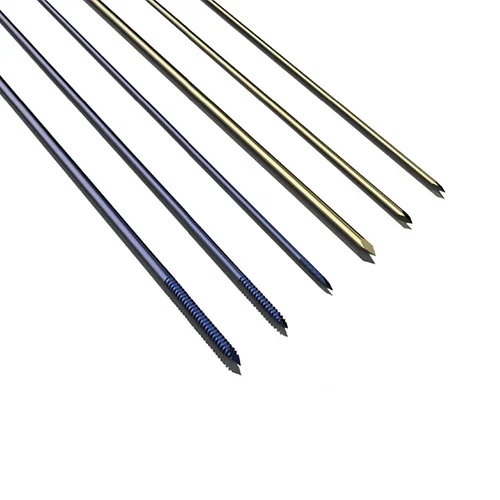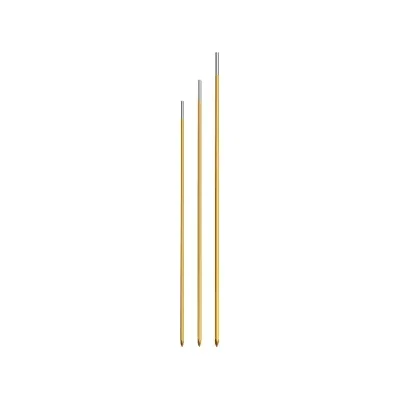Orthopedic surgery is a complex field that requires precision and accuracy. One of the most versatile tools in an orthopedic surgeon's arsenal is the Kirschner wire. This small but mighty tool has revolutionized the way surgeons approach bone fractures, joint dislocations, and other conditions that require surgical intervention. In this blog post, we will explore what Kirschner wires are, how they are used in orthopedic surgery, their advantages and features, different types of K-wires available today, as well as some techniques for using them effectively to achieve positive patient outcomes. Join us on this journey into the world of Kirschner wires!
What is Kirschner Wire?
Kirschner wires, also known as K-wires, are thin, sterilized metal wires that have been in use for over a century in orthopedic surgery. They were first developed by Dr. Martin Kirschner, a German surgeon who wanted to create an easy-to-use tool that could stabilize fractures and help with bone alignment.The wire itself is typically made of stainless steel or titanium alloy and ranges in size from 0.6mm to 2mm thick. It can be straight or curved depending on the procedure being performed.Once inserted into the body through small incisions or punctures, K-wires act as guiding tools for other surgical instruments such as drills and screws. They are commonly used for internal fixation of bone fractures and dislocations because they provide temporary stability until the healing process is complete.Because they're so versatile, K-wires can be used in many different procedures including hand surgeries, spinal fusions, hip replacements, ankle reconstructions among others. Additionally due to its design it can easily move through soft tissue while providing reliable support without interfering with bone growth making it an ideal option for pediatric patients too!

How is Kirschner Wire Used in Orthopedic Surgery?
Kirschner wire, also known as K-wire, is a versatile tool used by orthopedic surgeons for various procedures. This thin metal wire comes in different sizes and can be straight or curved to fit different areas of the body.One common use of K-wire in orthopedic surgery is for fracture fixation. The surgeon will insert the wire into the bone on either side of the fracture to hold it in place while it heals. Another use is for joint fusion where two bones are fused together using wires.In addition, K-wires can also be used during joint replacement surgeries where they help guide implant placement and ensure correct alignment.Surgeons can also use K-wires for temporary internal fixation before permanent implants are placed or as anchors for sutures during soft tissue repairs.Kirschner wires have become an essential tool in orthopedic surgery due to their versatility and effectiveness in treating various orthopedic conditions.
Types of Kirschner Wire
Kirschner wires come in different types, each suitable for specific surgical procedures. One type is the smooth K-wire, which has a pointed tip and smooth surface to reduce tissue damage during insertion. Another type is the threaded K-wire, which features threads along its length to provide better grip and stability when passing through bone fragments.The trocar-tipped K-wire is another common type that has a sharp pointed tip designed to penetrate dense cortical bone with ease. Meanwhile, the olive-tipped K-wire comes with a flattened end resembling an olive shape and works best for traction purposes or in guiding cannulated screws.Cannulated Kirschner wires are also becoming more popular among orthopedic surgeons because they allow for easier placement of implants without interfering with drilling or tapping equipment used during surgery. Flexible K-wires are available for use in more complex cases where flexibility is essential.It's important to note that not all types of Kirschner wire are appropriate for every surgical situation. Orthopedic surgeons must carefully consider factors such as patient anatomy and fracture location before selecting the proper size and type of wire necessary to achieve optimal outcomes.

Advantages and features of Kirschner Wire
Kirschner Wire, also known as K-wire, is a versatile tool used by orthopedic surgeons in various procedures. It has several advantages and features that make it an essential component of any surgical kit.One of the most significant advantages of K-wire is its flexibility. The wire can be bent into different shapes and sizes to accommodate the needs of each patient and procedure. This makes it an ideal choice for surgeries involving bones with complex shapes or fractures that require intricate repair.Another advantage of Kirschner Wire is its ability to provide excellent stability during bone healing. As the wire penetrates through both sides of a bone, it holds the fragments securely in place until they heal completely. Moreover, this minimizes the need for additional hardware such as plates or screws, reducing surgical time and costs.Additionally, K-wires are easy to insert and remove from patients' bones without causing extensive damage to surrounding tissues. This ensures faster healing times while reducing postoperative pain and discomfort for patients.The versatility and ease-of-use presented by Kirschner Wires have made them indispensable tools in orthopedic surgery today.
Kirschner Wire Techniques
Kirschner wire is a versatile tool that can be used in several orthopedic surgeries. The techniques involved in using Kirschner wire depend on the type of surgery being performed and the specific requirements of each patient.One common technique is called percutaneous pinning, which involves inserting Kirschner wires into a bone to stabilize it during healing. This technique is often used for fractures or dislocations in the fingers, hands, and wrists.Another technique involving Kirschner wire is external fixation, where pins are inserted through the skin and attached to an external frame to hold bones in place. This method can be useful for complex fractures or those requiring realignment.In some cases, Kirschner wires may also be used as part of a tension band wiring technique. This involves placing one or more wires around a broken bone with additional support from screws or plates.There are various techniques for using Kirschner wire depending on the unique needs of each patient and their specific injury. When utilized correctly by skilled orthopedic surgeons, these techniques can help promote proper healing and restore function to affected areas.

Conclusion
Kirschner wire is a versatile tool that has revolutionized the field of orthopedic surgery. It has made procedures less invasive and allowed for faster recovery times while also reducing complications. From treating fractures to correcting deformities, Kirschner wire continues to be an essential component in every orthopedic surgeon's toolkit.Euro-Tek Industrial Co., LTD is professional supplier of orthopedic medical implants and device for trauma, spine and wound care solutions.If you need,welcome to contact us.sales@inaturemedic.com













